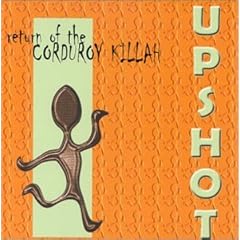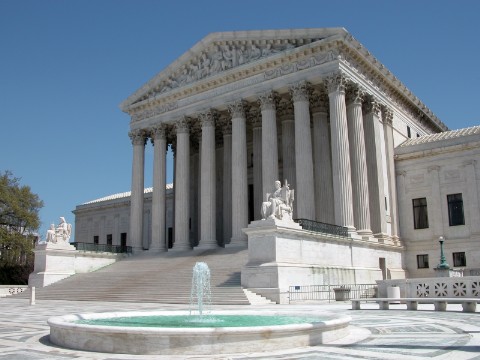The upshot of this enquiry
 In the mind of the casual observer, the idea of "empirical and mathematical analysis" -- which after all is the mission of Ratio Juris -- connotes a form of nonverbal thinking far afield from the linguistic nature of conventional legal scholarship. The admittedly frivolous inquiry I am about to undertake seeks to demonstrate that the language of judicial opinions lends itself to serious quantitative analysis.
In the mind of the casual observer, the idea of "empirical and mathematical analysis" -- which after all is the mission of Ratio Juris -- connotes a form of nonverbal thinking far afield from the linguistic nature of conventional legal scholarship. The admittedly frivolous inquiry I am about to undertake seeks to demonstrate that the language of judicial opinions lends itself to serious quantitative analysis.At an absolute minimum, the words used by Supreme Court Justices can be counted. Distinctive patterns in word use -- analyzed at either the morphological or syntactic level -- may hold clues to the thinking of individual Justices or of the Court as a whole. For now, let's ask a very simple question. What pet phrases set each Justice from the other members of the high court?
 For David Souter, that word is almost certainly enquire. When Justice Souter joined the Supreme Court in 1990, he introduced a spelling of the word inquire -- a variant of which I very consciously used in my opening paragraph -- that is reserved in the United States to two rather dissimilar groups: tabloid journalists and inveterate Anglophiles (especially individuals, evidently including Justice Souter, who are fond of subtle or overt ways to signal that they spent time at Oxford or Cambridge). I originally intended to trace Justice Souter's enquire signal, rendered as distinctly as an olfactory signature, across United States Reports. But Westlaw's decision to equate inquire and enquire blocked that plan.
For David Souter, that word is almost certainly enquire. When Justice Souter joined the Supreme Court in 1990, he introduced a spelling of the word inquire -- a variant of which I very consciously used in my opening paragraph -- that is reserved in the United States to two rather dissimilar groups: tabloid journalists and inveterate Anglophiles (especially individuals, evidently including Justice Souter, who are fond of subtle or overt ways to signal that they spent time at Oxford or Cambridge). I originally intended to trace Justice Souter's enquire signal, rendered as distinctly as an olfactory signature, across United States Reports. But Westlaw's decision to equate inquire and enquire blocked that plan. I then turned to my secondary target: Stephen Breyer. Like Justice Souter, Justice Breyer did a stint at Oxford. But the word that appears to distinguish Justice Breyer has no particular English provenance. It's upshot.
I then turned to my secondary target: Stephen Breyer. Like Justice Souter, Justice Breyer did a stint at Oxford. But the word that appears to distinguish Justice Breyer has no particular English provenance. It's upshot.According to Westlaw, upshot has appeared in 151 Supreme Court cases. It took the Court more than a century to log the first half of this record (74 cases), from Justice Matthews's majority opinion in Carite v. Trotol, 105 U.S. 751, 756 (1881) to Justice Blackmun's dissent in Ohio v. Akron Center for Reproductive Health, 497 U.S. 502, 538 (1990). The word is hardly a neologism; upshot in the sense of "the conclusion resulting from the premises of an argument" (one of the definitions listed in the Oxford English Dictionary) stems from the 17th century at the latest. From October Term 1990 through October Term 2005, however, the Court more than doubled the number of cases using upshot, all during a period of dramatic shrinkage in the Court's docket.
What is most striking about the 77 Supreme Court cases using upshot since October 1990 is the distribution of Justices who have used the word:
In other words, in twelve years on the Supreme Court, Justice Breyer has singlehandedly accounted for nearly a third of the institution's uses of upshot over the course of its history. Over those twelve years, Justice Breyer has signed 130 opinions. Nearly two-fifths of those opinions found some occasion to use upshot. Four of the other five Justices using the word have written it so sparingly that a complete list of citations is warranted:
Breyer 49 Souter 24 Roberts 1 O'Connor 1 Thomas 1 Ginsburg 1
- 44 Liquormart, Inc. v. Rhode Island, 517 U.S. 484, 525 (1996) (Thomas, J., concurring in part and concurring in the judgment)
- Reno v. Bossier Parish School Bd., 520 U.S. 471, 480 (1997) (O'Connor, J.)
- Norfolk S. Ry. v. Shanklin, 529 U.S. 344, 360 (2000) (Ginsburg, J.)
- Rapanos v. United States, 126 U.S. 2208, 2236 (2006) (Roberts, C.J., concurring).
 The truly interesting character is David Souter. He has contributed nearly half as many instances of upshot to United States Reports as Justice Breyer has. In the four Terms that he served before Stephen Breyer's arrival at the Court, Justice Souter used upshot twice. On one instance, Payne v. Tennessee, 501 U.S. 808, 844 (1991) (concurring opinion), Justice Souter merely quoted the word from an earlier source. Only in Lucas v. South Carolina Coastal Council, 505 U.S. 1003, 1078 (1992) (statement of Souter, J.) did David Souter use upshot on his own and without the arguable influence of Stephen Breyer.
The truly interesting character is David Souter. He has contributed nearly half as many instances of upshot to United States Reports as Justice Breyer has. In the four Terms that he served before Stephen Breyer's arrival at the Court, Justice Souter used upshot twice. On one instance, Payne v. Tennessee, 501 U.S. 808, 844 (1991) (concurring opinion), Justice Souter merely quoted the word from an earlier source. Only in Lucas v. South Carolina Coastal Council, 505 U.S. 1003, 1078 (1992) (statement of Souter, J.) did David Souter use upshot on his own and without the arguable influence of Stephen Breyer.Well, so what? Aside from exposing one of Stephen Breyer's linguistic quirks and demonstrating (perhaps) that this quirk has had some effect on David Souter, what does all this effort really prove? I freely admit that I have engaged merely in a small and totally frivolous exercise in word frequency counts. But that exercise has powerful historical roots, having contributed to one of the building blocks of the statistical analysis of right-skewed distributions. And it underlies an important and -- to my knowledge -- hitherto untapped source of new statistical learning. All this and more awaits a future series of posts outlining potential directions for mathematically sophisticated linguistic analysis of legal texts, including judicial opinions.
And that is the upshot of this enquiry.











0 Comments:
Post a Comment
<< Home